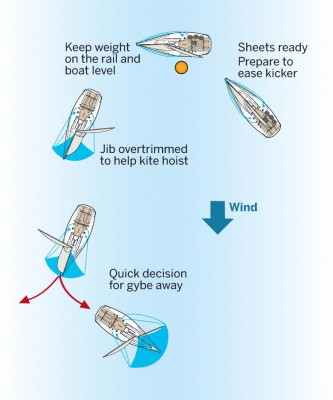There are rich pickings to be had at the windward mark. Jonty Sherwill asked top match racer Ian Williams for his five best tips for a smooth bear away
Mark roundings are often where big gains can be made and where mistakes can be costly. Nowhere is this more apparent than at the first weather mark where the fleet is tightly packed. Marks are the one place where everybody has to be and where the potential gains and losses are the greatest. Being fully prepared for the crucial seconds through the bear away is key to a good result.
Watch the better-prepared crews at any mark rounding and you can see the time they save. Even if fleet position in one-design racing is more important than elapsed time, saving time at every opportunity delivers more options and the chance to break through to the front. A fraction of an overlap here can translate into a big tactical advantage later on.
In the heat of competition to get to the windward mark it’s easy to get distracted from the vital task of preparing the boat for the bear away and deciding if a gybe-set will reap a better position at the end of the run.
That call is for the tactician, but depending on the size of boat and number of crew, it’s important that at least one person remains focused on making sure all lines are ready for when the bear away is called. That way a mad scramble to keep the boat on its feet and frustrated shouts such as ‘leeward tweaker off!’ are avoided.
Working up a personal checklist for each type of mark rounding will reduce the need for the stream of requests from the afterguard just when the pressure is on and develop the ideal working environment: a quiet boat.
1. Prepare the cockpit
Preparation is very important for a smooth mark rounding. This includes ensuring there are no snags in the sheets and that you have as many lines as possible pre-set or clearly marked (tweakers, pole uphaul, etc).
On a boat with a spinnaker pole it is even possible to pre-set the spinnaker sheet to a mark so it will set itself when you square the pole back, but be careful in a heavier breeze that the kite is fully hoisted and the halyard jammed before the sail fills.
2. Keep the boat flat
In anything other than light airs, the flatter you can keep the boat through the manoeuvre, the easier both the turn and the sail handling will be.
Important factors in this are keeping the crew weight hiking for as long as possible, easing the vang to depower the top of the mainsail and making sure there is enough room on the mark for the boom to go all the way out.
Keeping the jib over-trimmed will help both the bear away and the kite set.
3. Preventing twists
Twists normally come from the flow/vortices off the leech of the jib catching the leech of the spinnaker as it is hoisted. There are a few solutions: in light air on smaller boats you could furl the jib before the hoist, which will prevent twists and allow the spinnaker to set quickly, but requires very good crew co-ordination.
Another option is to keep the jib trimmed on harder to prevent any flow off the leech. Or you can delay the hoist, which again means there is no flow over the jib when the spinnaker is hoisted.
4. Curing twists
If you do get a twist in the spinnaker, the fastest way to clear it normally is to stay deep and keep the spinnaker collapsed, while pumping the halyard or pulling down on the leech. If that fails, you’ll probably just have to drop the spinnaker and unwind it manually.
Although sorting out a twist is disruptive to concentration, it is worth reminding yourself that if you’re sailing a heavier, non-planing type boat, the loss of time will be quite modest.
5. Tactics on boats behind and ahead
It is important that the helmsman knows what your strategy is for the downwind leg. If you surge forward on the boat ahead, you will have to make a quick decision as to whether to go to windward or to leeward of him and this choice may dictate your whole run.
You also need to know whether to defend from the boats behind you if they go high, or whether to let them go if you plan to gybe shortly anyway. As ever, communication is key to a smooth manoeuvre.
This is an extract from a feature in Yachting World September 2014 issue
Photo courtesy Rick Tomlinson.





